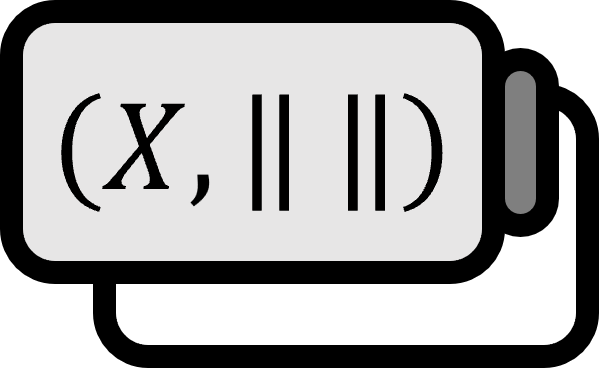Banach Fixed-Point Theorem Proof
Definition
Let $(X, \left\| \cdot \right\|)$ be a Banach space. A $T : X \to X$ that satisfies $\| T(x) - T ( \tilde{x} ) \| \le r \| x - \tilde{x} \|$ for all $x, \tilde{x} \in X$ and $0 \le r < 1$ is defined as a contraction mapping.
A $\alpha \in X$ that satisfies $T ( \alpha ) = \alpha$ is called a fixed point.
Theorem 1
The fixed point of $T$ exists uniquely.
Explanation
The Banach fixed-point theorem is also called the contraction mapping theorem, and it can be usefully applied in the solution of partial differential equations assuming a Hilbert space, mainly in numerical analysis dealing with methods on $\mathbb{R}^{n}$.
In fact, the norm itself is not necessary for the proof, so $X$ can be generalized to a complete metric space instead of a Banach space. If the distance of $(X , d)$ in a metric space is defined as $d (x,y) := \| x - y \|$, the exact same proof works.
Proof
Part 1. Continuity of $T$
If we assume $\displaystyle \delta := {{\varepsilon} \over {2}}$,
$$ \| x - \tilde{x} \| < \delta = {{ \varepsilon } \over { 2 r }} $$
$$ \implies \| T(x) - T ( \tilde{x} ) \| \le r \| x - \tilde{x} \| = {{\varepsilon } \over {2}} < \varepsilon $$
Therefore, $T$ is a continuous function in $X$.
Part 2. Existence of $\alpha$
Define a sequence $\left\{ x_{n} \right\}_{n \in \mathbb{N}}$ as $x_{n+1} := T ( x_{n} )$. Then,
$$ \| x_{n} - x_{n-1} \| = \| T(x_{n-1} )- T(x_{n-2}) \| = r \| x_{n-1} - x_{n-2} \| $$
Expanding recursively,
$$ \begin{align*} \| x_{n} - x_{n-1} \| =& r \| x_{n-1} - x_{n-2} \| \\ =& r^2 \| x_{n-2} - x_{n-3} \| \\ \vdots& \\ =& r^{n-1} \| x_{1} - x_{0} \| \end{align*} $$
Now, if we let $n = m + k$ for $n, m, k \in \mathbb{N}$, by the triangle inequality,
$$ \begin{align*} \| x_{n} - x_{m} \| =& \| x_{m+k} - x_{m} \| \\ \le & \| x_{m+k} - x_{m+(k-1) } \| + \cdots + \| x_{m+k} - x_{m+(k-1) } \| \\ \le & \| x_{m+1} - x_{m } \| \left( 1 + r + \cdots + r^{k} \right) \\ \le & \| x_{m+1} - x_{m } \| {{1 - r^{k}} \over {1 - r}} \\ \le & \| x_{m+1} - x_{m } \| {{1 } \over {1 - r}} \\ \le & {{ r^{m-1} } \over {1 - r}} \| x_{1} - x_{0} \| \end{align*} $$
Therefore, $\left\{ x_{n} \right\}_{n \in \mathbb{N}}$ is a Cauchy sequence. Since $X$ is a Banach space, when $n \to \infty$ then $x_{n}$ converges to some $\alpha \in X$. From Part 1., since $T$ is continuous,
$$ \begin{align*} T ( \alpha ) =& T \left( \lim_{n \to \infty } x_{n} \right) = \lim_{n \to \infty } T(x_{n} ) \\ =& \lim_{n \to \infty } x_{n+1} \\ =& \alpha \end{align*} $$
Hence, $\alpha$ is a fixed point of $T$.
Part 3. Uniqueness of $\alpha$
Let $\beta \in X$ also be a fixed point of $T$.
$$ \| \alpha - \beta \| \le \| T( \alpha ) - T ( \beta ) \| \le r \| \alpha - \beta \| $$
$$ \implies (1 - r ) \| \alpha - \beta \| \le 0 $$
$$ \implies \| \alpha - \beta \| \le 0 $$
$$ \implies \alpha = \beta $$
Therefore, the fixed point $\alpha \in X$ of $T$ is unique.
■
Or it can also be said that since a Banach space is a metric space, it is a Hausdorff space, and in a Hausdorff space, a sequence converges uniquely.
Kreyszig. (1989). Introductory Functional Analysis with Applications: p300~302. ↩︎
